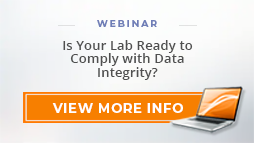So, you’ve decided that your organization needs a new LIMS. However, you need to secure funding to move forward. Your management has asked you to justify the purchase of the LIMS, but where do you start?
Justifications for investing in a LIMS can be divided into two categories: quantitative and qualitative. Quantitative measures are the easiest to determine. They will provide direct monetary justification and measurable Return on Investment (ROI) figures. Even if they’re less clear, qualitative factors should not be ignored because these justifications can be equally as compelling and have been known to tip the balance during the appropriation process.
There are specific outputs to be considered for each aspect of the justification. This blog post walks you through the process of documenting each of them as you build the case for a new LIMS.
Quantitative LIMS Justification
Let’s start with the quantitative category. Quantitative justifications include measurable cost savings, typically via time savings and efficiency gains. When you are documenting these factors, look for workflow bottlenecks, manual processes, and repetitive tasks in your laboratory that can be alleviated through LIMS automation. Some of the classic areas to analyze include:
- Data analysis
- Report generation
- Sample and test status updates
- Sample throughput
- Work assignment and load levelling
- Inventory tracking for samples and consumables
- Calculations
- Manual results entry
- Manual entry of information into other systems (i.e., ERP, MES, Accounting, etc.)
- Results review and release
- Audit preparedness/regulatory information availability
- Storage and maintenance of data
- Time spent tracking and rectifying errors
The overall themes among the quantitative gains of a LIMS implementation are reduced labor costs, faster turnaround time, increased throughput, and reduced errors.

Depending on your existing laboratory resources, some of these points may not apply. If you’re an entirely paper-based lab, your justifications will be different than if you currently have a LIMS in place with all your instruments and systems integrated and are looking to upgrade or change your LIMS software. If the latter is your situation, you will need to be more creative in your quantitative analysis; consider why you feel the need to change your existing system. What are you missing, or what is not working effectively, that you hope a new system will be able to address?
The next step, once you have identified inefficiencies in your current processes, is to determine how much time and effort is spent on these tasks per day or week. Once you have those numbers, you can estimate how much time it would take to do this if a LIMS and the associated interfaces (instruments and systems) were in place; this is often zero. Subtracting the two will yield your time savings, which are then extrapolated for a full year. Take the yearly time savings and multiply it by the fully loaded costs (i.e., salary and benefits) of the resource generally performing the task and you will derive the yearly cost savings of having a LIMS. Be sure to include any production or manufacturing efficiencies or cost reductions (if applicable) and any reductions in time to market in your quantitative justification category.
To develop your ROI, you will need to develop the yearly costs of the LIMS including software and user licensing, software support, hardware, and personnel (system administrators, IT, etc.). Most organizations target a three-year or less ROI period for capital expenditure but check with your management for what your company is looking for. Then, apply the yearly cost savings to the yearly costs of the LIMS and derive the values for the ROI period.
It is important while going through the quantitative justification process that you clarify that reduced headcount is not a goal but rather you want to alleviate the repetitive and mundane tasks so that your scientists and technicians can do what they are really supposed to do—pursue science.
In summary, to understand the quantitative justifications for your LIMS project, execute the following nine steps:
- Asses current workflows to identify process inefficiencies
- Measure the time and effort spent on the tasks identified in step 1 (current effort)
- Estimate how much time, if any, it will take to perform the equivalent of those tasks in LIMS (future effort)
- Subtract future effort from current effort to determine time savings per task
- Multiply time savings per task by the estimated number of times the task is performed in a year (annual time savings)
- Multiply annual time savings by the full cost (salary, benefits) of the resource who performs the task (personnel annual cost savings)
- Include any additional potential cost savings, e.g., manufacturing efficiency or cost reduction and reduced time to market, sunsetting of older systems (total annual cost savings)
- Estimate annual cost of LIMS, including licensing, infrastructure, hardware, IT personnel, and so on
- Subtract annual cost of LIMS from total annual cost savings (ROI)
Qualitative LIMS Justification
Qualitative justifications may feel murkier given that they lack solid numbers, but you should not neglect this category. Even though a hard cost savings number cannot be derived from these items, they are still valuable and often end up being the deciding factors in gaining your project approval. Some prime examples of qualitative justifications include:
- Increased availability of information
- Increased innovation
- Increased collaboration
- Improved scientific effectiveness
- Improved data quality
- Better decision making
- Increased customer satisfaction
- Increased staff satisfaction and engagement
- Reduced risk and additional mitigation strategies
- Increased regulatory compliance
It may be difficult to attach a monetary value to qualitative criteria, but if your status quo is holding you back, you’ll notice the value in them once you get a system in place that moves your company forward.
Decreasing manual entry, automating data capture, and replacing inefficient systems can decrease human errors, ensuring increased data quality and integrity. Better data means better decision making, with real-time data access and advanced reporting capabilities that allow you to track KPIs and identify issues efficiently. A LIMS simplifies all the complicated minutiae of regulatory compliance by maintaining audit trails and traceable data records, which save you time on audit preparation and reduce the risk of penalties. Streamlining and automating routine tasks frees up your staff to focus on high-value (and more satisfying) activities, potentially boosting productivity and morale.
Combine your quantitative justifications and ROI with your qualitative justifications when you submit your capital appropriation request and you will shortly be able to develop your requirements so you can start your LIMS selection.
If these justifications seem too time consuming for you to achieve alone, never fear. There are informatics consulting organizations that can help. When selecting a consulting organization to assist you in justifying your LIMS project, you should ensure that they are:
- Experts in LIMS, laboratory work processes, and laboratory data and information flows (get references!)
- Domain experts (i.e., your industry and your type of lab)
- IT experts
- Regulatory experts (if your lab is in a regulated environment)
- LIMS vendor neutral
_____
Have you gone through the process of justifying a LIMS for your lab using both quantitative and qualitative factors?




Comments